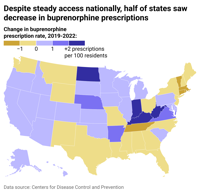Ophelia used CDC data to map the growing distribution of common medications that prevent opioid overdoses and treat substance use disorders.
Naloxone access grows across the US
Updated
Despite having the highest drug overdose death rate, West Virginia ranked 12th in naloxone prescriptions at 0.7 per 100 people in 2022. However, the state saw the fifth-highest growth in naloxone prescriptions, growing from 0.3 per 100 people in 2019.
Arkansas dispensed the most naloxone prescriptions, perhaps contributing to its relatively low rate of drug overdose deaths at 21.7 per 100 people. Arkansas saw the biggest jump in naloxone prescriptions, increasing from 0.1 prescriptions per 100 people in 2019 to 1.7 per 100 people in 2022.
After Arkansas, the top states for growth in naloxone prescriptions were:
- Kentucky (+0.8 per 100 people)
- South Carolina (+0.8)
- Tennessee (+0.6)
Access to naloxone grew in every state except New Mexico, where it shrank, and New Hampshire, where it stayed the same. Overall, naloxone prescriptions per resident remain much lower than buprenorphine due in part to the different purposes each drug serves.
Naloxone is used in emergencies and is not prescribed as a medication to take on a routine basis. In addition to over-the-counter purchases, the drug is distributed through public health programs and emergency care outside traditional prescription avenues. Buprenorphine, on the other hand, is dispensed only by health care providers for long-term opioid use disorder treatment to ease withdrawal symptoms and cravings, often necessitating refills on a regular basis for complete treatment.
Cost is also an issue. A two-dose packet of Narcan runs just under $50 at many drugstores, and like most over-the-counter drugs, insurance doesn't cover it. While a lifesaving measure might seem worth the price tag, $50 is prohibitive for some. To help reach communities in need, there are several resources available for free naloxone supplies and emergency kits.
Despite efforts to reduce the stigma around substance-related disorders, walking into a Walgreens or CVS and purchasing overdose medication might be challenging for those with OUD.
However, the use of lifesaving treatments is imperative as the opioid epidemic continues to take its toll. Obsolete and incorrect beliefs about the nature of addiction, which liken the disease to moral failure, can prevent people from seeking help and hinder the development of health and public policies. In contrast, a punitive approach to OUD can increase drug use by dehumanizing those who need help while failing to address the underlying cause of the disease.
Some areas see a decline in substance misuse treatment medication distribution
Updated
Medication-based treatment has not been a first line of defense in treating opioid misuse disorder long-term. According to a study by the NIH and CDC, just over 1 in 5 adults with opioid use disorder received medication-based treatment, namely buprenorphine, methadone, or naltrexone, in 2021. The study also found that Schedule III, II, and unscheduled drugs, respectively, were dispensed for substance use treatment 38 times more often when it was a telehealth appointment.
West Virginia leads in prescriptions per capita, which have increased by 4.4 prescriptions per 100 residents to reach 27.2—over a quarter of the state's total population. Indiana, whose capital city is a national hotspot for opioid overdoses, saw the second-highest increase in buprenorphine prescriptions, reaching 10.7 per 100 residents in 2022.
Despite having the second most overdoses due to opioids, the District of Columbia issued an average of 1.5 fewer prescriptions per 100 people. Prescriptions fell the most in Vermont by 3.1 overall, dropping from 28.6 per 100 people to 25.5 per 100 people. In 2021, the state became the first to decriminalize buprenorphine possession in limited quantities. In a promising outlook for this harm reduction strategy, Vermont is experiencing a three-year low in opioid overdose rates based on 2024 data so far.
Story editing by Alizah Salario. Additional editing by Kelly Glass. Copy editing by Kristen Wegrzyn.
This story originally appeared on Ophelia and was produced and distributed in partnership with Stacker Studio.
How access to opioid treatments is growing across the country
Updated
Drug overdoses are a leading cause of accidental death in the United States. Among all overdose deaths, opioids were the culprit 70.6% of the time in 2019, according to the Centers for Disease Control.
Nearly 30 years after the first wave of the opioid epidemic began, roughly 645,000 Americans have died from overdoses where prescription or illicit opioids were involved, according to the CDC. Current estimates indicate that between 6.7 and 7.6 million Americans suffer from opioid use disorder.
Beginning in 2013, the introduction of synthetic opioids like fentanyl and xylazine into the drug supply sparked a surge in opioid overdose deaths. According to the Department of Health & Human Services Overdose Prevention Strategy, drug overdose deaths due to synthetic opioids besides methadone have increased an astounding 103-fold since 1999 and are the primary driver of overdose deaths.
During an overdose, opioids bind to receptors in the brain that control respiratory function, leading to impaired breathing and amounting to brain damage and death due to lack of oxygen. In recent years, drugs to treat substance use disorder and prevent overdose deaths have surged in usage.
Naloxone, available as a nasal spray or injectable medication, can reverse opioid overdoses after they happen. The drug, often known by the brand name Narcan, was made available over the counter in 2023 in an effort by the Food and Drug Administration to increase accessibility. Nearly 1.7 million prescriptions of naloxone were dispensed in 2022, up from 904,000 in 2019.
Buprenorphine, however, must be prescribed by a health care provider as part of a long-term substance misuse treatment plan, often for those addicted to heroin, oxycodone, fentanyl, or other opiates. Buprenorphine works by reducing withdrawal symptoms and curbing drug cravings. As a long-acting opioid, it takes more time to act on the body over a more extended period. Though it's classified as a Schedule III drug due to its addictive properties, at the correct dosage it helps give people suffering from addiction a level of stability by reducing the harms of illicit opioid misuse.
About 16 million buprenorphine prescriptions were dispensed in 2022, slightly higher than in 2019. However, as the epidemic retains its grip on the nation, medical professionals are prescribing opioids for pain relief with less frequency. The rate of opioid prescriptions for pain fell steadily between 2019 and 2022, from 46.8 per 100 people in 2019 to 39.5 per 100 people in 2022. The prescription rate for opioid treatment drug buprenorphine, meanwhile, slightly increased over the same period from 4.7 to 4.8 prescriptions per 100 people.
Part of this increased access is due to the $50 billion opioid settlement fund distributed to each state for opioid harm reduction and treatment services. Many states are in the process of determining how to deploy settlement funds; the level of access to lifesaving medications thus varies by state and their specific approach to combating the crisis.
To compare how states are utilizing these funds, Ophelia used CDC data to map the growing distribution of common medications that prevent opioid overdoses and treat substance use disorders.

Originally published on ophelia.com, part of the BLOX Digital Content Exchange.





















(0) comments
Welcome to the discussion.
Please log in, or sign up for a new, free account to read or post comments.
Log In
Keep it Clean. Please avoid obscene, vulgar, lewd, racist or sexually-oriented language.
PLEASE TURN OFF YOUR CAPS LOCK.
Don't Threaten. Threats of harming another person will not be tolerated.
Be Truthful. Don't knowingly lie about anyone or anything.
Be Nice. No racism, sexism or any sort of -ism that is degrading to another person.
Be Proactive. Use the 'Report' link on each comment to let us know of abusive posts.
Share with Us. We'd love to hear eyewitness accounts, the history behind an article.